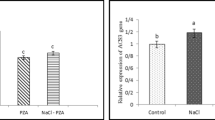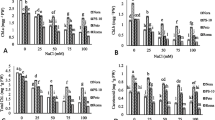Abstract
The purpose of this research was to find out how in vitro cultured of tomato explants responded to salt stress after addition of silver nitrate (AgNO3) and pyrazinamide (PZA) as ethylene inhibitors. One of the plant hormones involved in salinity response is ethylene, considered as a stress hormone. The impact of ethylene accumulated in the closed container of plant cells and tissues grown in vitro either with or without salinity stress is different and depends on plant species and even the plant cultivar. Salt stress in tomato plants increases ethylene accumulation, induces leaf epinasty, and reduces growth or viability. Tomato seedlings were grown on MS medium containing NaCl (0, 100, 150 mM) and supplemented with AgNO3 (0, 2, 4, mg L−1) and PZA (0, 2, 4 mg L−1) to study growth parameters and antioxidant enzymes responses. Salt-stressed plants showed limited growth and a significant decrease in fresh and dry weight. Salinity accelerated oxidative damage by increasing hydrogen peroxide (H2O2) and malondialdehyde (MDA) levels in tomato leaves. In presence of AgNO3 and PZA, in vitro grown tomato plants exhibited increased fresh and dry weight, total chlorophyll and carotenoids, in particular at 4 mg L−1 AgNO3 and 4 mg L−1 PZA. Moreover, silver nitrate and PZA reduced H2O2 and MDA contents as well as oxidative damage by enhancing antioxidant enzyme activity, including catalase, superoxide dismutase, and ascorbate peroxidase under salt stress. Thus, AgNO3 and PZA improved in vitro salinity tolerance of tomato plantlets by interfering with ethylene action or ethylene generation as well as by increasing biochemical responses.



Similar content being viewed by others
References
Acosta Motos JR, Ortuño MF, Bernal Vicente A, Diaz Vivancos P, Sanchez Blanco MJ, Hernandez JA (2017) Plant responses to salt stress: adaptive mechanisms. Agronomy 7:18. https://doi.org/10.3390/agronomy7010018
Aebi H (1984) Catalase in vitro. Method Enzymol. https://doi.org/10.1016/S0076-6879(84)05016-3
Ahmed W, Imran M, Yaseen M, ul Haq T, Jamshaid MU, Rukh S, Ikram RM, Ali M, Ali A, Maqbool M (2020) Role of salicylic acid in regulating ethylene and physiological characteristics for alleviating salinity stress on germination, growth and yield of sweet pepper. Peer J 8:e8475. https://doi.org/10.7717/peerj.8475
Al Ramadan R, Karas M, Ranušová P, Moravčíková J (2021) Effect of silver nitrate on in vitro regeneration and antioxidant responses of oilseed rape cultivars (Brassica napus L). J Microbiol Biotechnol Food Sci 10:e4494. https://doi.org/10.15414/jmbfs.4494
Albacete A, Martínez Andújar C, Ghanem ME, Acosta M, Sanchez Bravo J, Asins MJ, Cuartero J, Lutts S, Dodd IC, Perez Alfocea F (2009) Rootstock-mediated changes in xylem ionic and hormonal status are correlated with delayed leaf senescence, and increased leaf area and crop productivity in salinized tomato. Plant Cell Environ 32:928–938. https://doi.org/10.1111/j.1365-3040.2009.01973.x
Arnon DI (1949) Copper enzymes in isolated chloroplasts. Polyphenoloxidase in Beta vulgaris. Plant Physiol 24:1. https://doi.org/10.1104/pp.24.1.1
Beauchamp C, Fridovich I (1971) Superoxide dismutase: improved assays and an assay applicable to acrylamide gels. Anal Biochem 44:276–28. https://doi.org/10.1016/0003-2697(71)90370-8
Bidabadi SS, Sharifi P, Latef AAHA (2021) Antioxidant enzymes and salt stress in plants. Organic solutes, oxidative stress, and antioxidant enzymes under abiotic stressors. CRC Press, Boca Raton, pp 213–232
Biddington N (1992) The influence of ethylene in plant tissue culture. Plant Growth Regul 11:173–118. https://doi.org/10.1007/BF00024072
Bleecker AB, Kende H (2000) Ethylene: a gaseous signal molecule in plants. Annu Rev Cell Dev Biol 16:1–18. https://doi.org/10.1146/annurev.cellbio.16.1.1
Bradford MM (1976) A rapid and sensitive method for the quantification of microgram quantities of protein utilizing the Principle of Protein-Dye Binding. Anal Biochem 72:248–254. https://doi.org/10.1016/0003-2697(76)90527-3
Brito FA, Pimenta TM, Henschel JM, Martins SC, Zsögön A, Ribeiro DM (2020) Elevated CO2 improves assimilation rate and growth of tomato plants under progressively higher soil salinity by decreasing abscisic acid and ethylene levels. Environ Exp Bot 176:104050. https://doi.org/10.1016/j.envexpbot.2020.104050
Chae SC, Kim HH, Park SU (2012) Ethylene inhibitors enhance shoot organogenesis of gloxinia (Sinningia speciosa). Sci World J. https://doi.org/10.1100/2012/859381
Elatafi E, Fang J (2022) Effect of silver nitrate (AgNO3) and Nano-Silver (Ag-NPs) on physiological characteristics of grapes and quality during storage period. Horticulturae 8:419. https://doi.org/10.3390/horticulturae8050419
Ghanem ME, Albacete A, Martínez Andújar C, Acosta M, Romero-Aranda R, Dodd IC, Lutts S, Pérez Alfocea F (2008) Hormonal changes during salinity-induced leaf senescence in tomato (Solanum lycopersicum L). J Exp Bot 59:3039–3050. https://doi.org/10.1093/jxb/ern153
Hasanuzzaman M, Bhuyan MB, Zulfiqar F, Raza A, Mohsin SM, Mahmud JA, Fujita M, Fotopoulos V (2020) Reactive oxygen species and antioxidant defense in plants under abiotic stress: revisiting the crucial role of a universal defense regulator. Antioxidants 9:681. https://doi.org/10.3390/antiox9080681
Heath RL, Packer L (1968) Photoperoxidation in isolated chloroplasts: I. Kinetics and stoichiometry of fatty acid peroxidation. Arch Biochem Biophys 125:189–198. https://doi.org/10.1016/0003-9861(68)90654-1
Khan I, Raza MA, Awan SA, Shah GA, Rizwan M, Ali B, Tariq R, Hassan MJ, Alyemeni MN, Brestic M (2020) Amelioration of salt induced toxicity in pearl millet by seed priming with silver nanoparticles (AgNPs): the oxidative damage, antioxidant enzymes and ions uptake are major determinants of salt tolerant capacity. Plant Physiol Biochem 156:221–232. https://doi.org/10.1016/j.plaphy.2020.09.018
Khan I, Awan SA, Raza MA, Rizwan M, Tariq R, Ali S, Huang L (2021) Silver nanoparticles improved the plant growth and reduced the sodium and chlorine accumulation in pearl millet: a life cycle study. Environ Sci Pollut Res 28:13712–13724. https://doi.org/10.1007/s11356-020-11612-3
Lanahan MB, Yen H-C, Giovannoni JJ, Klee HJ (1994) The never ripe mutation blocks ethylene perception in tomato. Plant Cell 6:521–530. https://doi.org/10.1105/tpc.6.4.521
Lichtenthaler HK (1987) Chlorophylls and carotenoids: pigments of photosynthetic biomembranes. Method Enzymol. https://doi.org/10.1016/0076-6879(87)48036-1
Murashige T, Skoog F (1962) A revised medium for rapid growth and bio assays with tobacco tissue cultures. Physiol Plant 15:473–497. https://doi.org/10.1111/j.1399-3054.1962.tb08052.x
Nakano Y, Asada K (1987) Purification of ascorbate peroxidase in spinach chloroplasts; its inactivation in ascorbate-depleted medium and reactivation by monodehydroascorbate radical. Plant Cell Physiol 28:131–140. https://doi.org/10.1093/oxfordjournals.pcp.a077268
Nejatzadeh F (2021) Effect of silver nanoparticles on salt tolerance of Satureja hortensis l. During in vitro and in vivo germination tests. Heliyon 7:e05981. https://doi.org/10.1016/j.heliyon.2021.e05981
Netondo GW, Onyango JC, Beck E (2004) Sorghum and salinity: II. Gas exchange and chlorophyll fluorescence of sorghum under salt stress. Crop Sci 44:806–811. https://doi.org/10.2135/cropsci2004.7970
Omoto E, Kawasaki M, Taniguchi M, Miyake H (2009) Salinity induces granal development in bundle sheath chloroplasts of NADP-malic enzyme type C4 plants. Plant Prod Sci 12:199–207. https://doi.org/10.1626/pps.9.256
Poór P, Kovács J, Borbély P, Takács Z, Szepesi Á, Tari I (2015) Salt stress-induced production of reactive oxygen-and nitrogen species and cell death in the ethylene receptor mutant never ripe and wild type tomato roots. Plant Physiol Biochem 97:313–322. https://doi.org/10.1016/j.plaphy.2015.10.021
Prem Kumar G, Sivakumar S, Siva G, Vigneswaran M, Senthil Kumar T, Jayabalan N (2016) Silver nitrate promotes high-frequency multiple shoot regeneration in cotton (Gossypium hirsutum L.) by inhibiting ethylene production and phenolic secretion. In Vitro Cell Dev Biology-Plant 52:408–418. https://doi.org/10.1007/s11627-016-9782-5
Riyazuddin R, Verma R, Singh K, Nisha N, Keisham M, Bhati KK, Kim ST, Gupta R (2020) Ethylene: a master regulator of salinity stress tolerance in plants. Biomolecules 10:959. https://doi.org/10.3390/biom10060959
Sgamma T, Thomas B, Muleo R (2015) Ethylene inhibitor silver nitrate enhances regeneration and genetic transformation of Prunus avium (L.) cv Stella. Plant Cell Tissue and Organ Culture (PCTOC) 120:79–88. https://doi.org/10.1007/s11240-014-0581-6
Shafi M, Bakht J, Khan MJ, Khan MA, Anwar S (2010) Effect of salinity on yield and ion accumulation of wheat genotypes. Pak J Bot 42:4113–4121
Shah FA, Wei X, Wang Q, Liu W, Wang D, Yao Y, Hu H, Chen X, Huang S, Hou J (2020) Karrikin improves osmotic and salt stress tolerance via the regulation of the redox homeostasis in the oil plant Sapium sebiferum. Front Plant Sci 11:216. https://doi.org/10.3389/fpls.2020.00216
Shaikhaldein HO, Al-Qurainy F, Nadeem M, Khan S, Tarroum M, Salih AM, Alansi S, Al-Hashimi A, Alfagham A, Alkahtani J (2022) Assessment of the impacts of green synthesized silver nanoparticles on Maerua oblongifolia shoots under in vitro salt stress. Materials 15:4784. https://doi.org/10.3390/ma15144784
Shibli RA, Kushad M, Yousef GG, Lila MA (2007) Physiological and biochemical responses of tomato microshoots to induced salinity stress with associated ethylene accumulation. Plant Growth Regul 51:159–169. https://doi.org/10.1007/s10725-006-9158-7
Sun X, Li Y, He W, Ji C, Xia P, Wang Y, Du S, Li H, Raikhel N, Xiao J (2017) Pyrazinamide and derivatives block ethylene biosynthesis by inhibiting ACC oxidase. Nat Commun 8:1–14. https://doi.org/10.1038/ncomms15758
Taffouo V, Nouck A, Dibong S, Amougou A (2010) Effects of salinity stress on seedlings growth, mineral nutrients and total chlorophyll of some tomato (Lycopersicum esculentum L.) cultivars. Afr J Biotechnol 9(33):5366–5372
Tamimi SM (2015) Effects of ethylene inhibitors, silver nitrate (AgNO3), cobalt chloride (CoCl2) and aminooxyacetic acid (AOA), on in vitro shoot induction and rooting of banana (Musa acuminata L). Afr J Biotechnol 14:2511–2516. https://doi.org/10.5897/AJB2015.14788
Tao JJ, Chen HW, Ma B, Zhang WK, Chen SY, Zhang JS (2015) The role of ethylene in plants under salinity stress. Front Plant Sci 6:1059. https://doi.org/10.3389/fpls.2015.01059
Theologis A (1992) One rotten apple spoils the whole bushel: the role of ethylene in fruit ripening. Cell 70:181–184
Thuesombat P, Hannongbua S, Ekgasit S, Chadchawan S (2016) Effects of silver nanoparticles on hydrogen peroxide generation and antioxidant enzyme responses in rice. J Nanosci Nanotechnol 16:8030–8043. https://doi.org/10.1166/jnn.2016.12754
Velikova V, Yordanov I, Edreva A (2000) Oxidative stress and some antioxidant systems in acid rain-treated bean plants: protective role of exogenous polyamines. Plant Sci 151:59–66. https://doi.org/10.1016/S0168-9452(99)00197-1
Zhao S, Zhang Q, Liu M, Zhou H, Ma C, Wang P (2021) Regulation of plant responses to salt stress. Int J Mol Sci 22:4609. https://doi.org/10.3390/ijms22094609
Acknowledgements
The authors are grateful to the University of Isfahan and the Plant Antioxidant Center of Excellence (PACE) for their support.
Funding
Not applicable.
Author information
Authors and Affiliations
Contributions
SZ carried out the experimental lab analysis and wrote the first draft of the manuscript, AAE edited, organized, and submitted the manuscript.
Corresponding author
Ethics declarations
Competing interests
The authors declare that they have no conflict of interests either financially or non-financially and no plagiarism on the submitted manuscript.
Additional information
Communicated by Sergio J. Ochatt.
Publisher’s Note
Springer Nature remains neutral with regard to jurisdictional claims in published maps and institutional affiliations.
Supplementary Information
Below is the link to the electronic supplementary material.
Rights and permissions
Springer Nature or its licensor (e.g. a society or other partner) holds exclusive rights to this article under a publishing agreement with the author(s) or other rightsholder(s); author self-archiving of the accepted manuscript version of this article is solely governed by the terms of such publishing agreement and applicable law.
About this article
Cite this article
Zarei, S., Ehsanpour, A.A. Ethylene inhibition with silver nitrate (AgNO3) and pyrazinamide (PZA) ameliorates in vitro salt tolerance of tomato (Lycopersicon esculentum L) plantlets. Plant Cell Tiss Organ Cult 154, 239–247 (2023). https://doi.org/10.1007/s11240-023-02511-9
Received:
Accepted:
Published:
Issue Date:
DOI: https://doi.org/10.1007/s11240-023-02511-9




